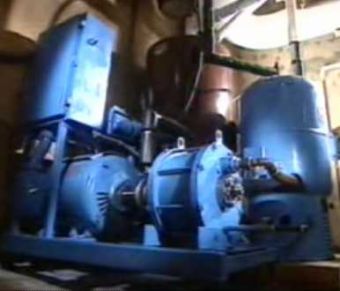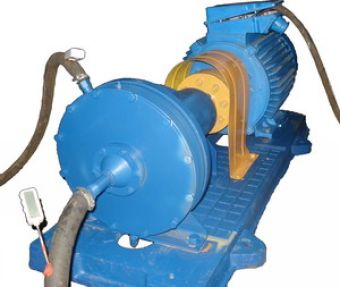|
Technically cavitation heaters are simply devices that transfer mechanical energy into thermal energy in a working fluid. The common design amounts to a very inefficient centrifugal pump.The energy conversion in a cavitation heater has well known advantages in industrial applications where the working fluid can be damaged by contact with heating elements with a significant temperature differential.
For example some food processing and chemical processing applications where there some constituents of the fluid may come out of solution on a heat transfer surface (as in mineralization in water heaters and boilers) or where on-demand heating is needed (as in water for residential or commercial uses). Established commercial vendors serve these industrial markets. -source.
There are a few companies who have developed caviation devices, please check the link above for a list of businesses currently supplying cavitaiton products.
However there is a more efficent use of cavitation technology possible. Specifically by using the rotation of a rotor with holes that creates hot water or steam nearly instantaneously. As a result this process is producing 70% more energy than was put into the system.
Fueless water hammer disclosure.

At Rome, Georgia Jim Griggs of Hydrodynamics, Inc demonstrated the assembly and operation of a "hydrosonic water pump" which operated over-unity by producing hot water or steam with energy in excess of the electrical energy input to the pump motor. "Over-unity" was confirmed by satisfied customers, including the Albany Fire Station, where engineers from the "local university" and the "local power company" had been called in to verify the over-100% efficiency.
Video Disclosure
Quote-James Griggs’ Hydrosonic Pump is already being sold to customers, regularly providing them with over-unity energy. An energy efficiency consultant from Georgia, Griggs invented the pump as a result of his curiosity about a common phenomenon called water hammer or cavitation. Griggs noticed that heat emanated from fluids, which flow quickly through the pipes of a boiler causing water pressure to drop in part of the pipe. Bubbles formed in the low-pressure areas collapse when carried to areas of higher pressure. The resulting shock waves collide inside the pipe bringing about the water hammer effect.
Griggs’ pump is made up of a cylindrical rotor that fits closely within a steel case. When the rotor spins, water is forced through the shallow space between the rotor and the case. The resulting acceleration and turbulence created in the gap somehow heats the water and creates steam. In 1988, a testing expert found that the heat energy put out by the hydrosonic pump was 10 to 30% higher than energy used to turn the rotor.
In 1990, Griggs started Hydrodynamics, Inc. He and his partner have invested over a million dollars in the business. The units they are selling are not only more efficient than standard boilers but they also require less maintenance. They are self-cleaning and eliminate the problem of mineral build-up that reduces the efficiency of standard boilers. Georgia Power and the civil engineering department at Georgia Institute of Technology are currently conducting studies of the pump.
A new cavitation device similar to the Griggs machine is now available for testing, scientific investigation and purchase by research laboratories. This is the
"Kinetic Furnace" of Kinetic Heating Systems, Inc. of Cumming, Georgia. Jointly invented by Eugene Perkins and Ralph E. Pope, the furnace is a heat-producing rotary cavitation device for which the inventors have been granted four United States patents, the most recent one in 1994. Numerous independent companies and testing agencies have found the same over-unity performance: Coefficient of Performance or C.O.P.(the ratio of output to input power) in the range 1.2 to as high as 7.0, with most typical operation in the range 1.5 to 2.0. Dr. Mallove and Jed Rothwell of Infinite Energy recently confirmed the excess heat in a preliminary on-site test.
The reactions responsible for the excess energy in the Perkins-Pope device may be novel nuclear reactions or the tapping of energy reservoirs that some have referred to as new hydrogen energy states or zero point energy. There is no possibility, according to Dr. Mallove, that the device can be explained by chemical energy or "storage energy". -End quote. Link.
In 2002 the Akoils heat generator (VHG) has been shown to be able to generate cheap thermal energy and hot water. Heat generators have the coefficient of energy conversion (electrical – mechanical – thermal), which is much more than 100%.
Web site.

They produce universal, non-polluting plants with very low electricity consumption and a high thermal energy output (transformation coefficient of electrical energy into thermal one is over 100 %), working without heating devices, are intended for heating systems of the industrial factories, housing and communal services and private dwellings.
This available protoype proves that a vortex heat generator (VHG) can produce more thermal energy out than it electrical energy input in.
Despite these individuals having a working available device, this scientific find has no faculty recognition, and they are further unable to get faculties to present and accept these findings.
Their contributions need a grant backed research and development environment to flourish and will be grant backed and submitted into faculty study in the proposed Panaceas research and development center.
If you're a member of the public or a scientific group which can aid in grants for the center or help cavitation research, please contact Panacea.
Note additionally Panacea's open sourced engineer's Roto Verter technology can also significantly improve this technology's efficiency.
Research links
Link
Link
Link
Link
Link
Link
Link
Link
Link
|